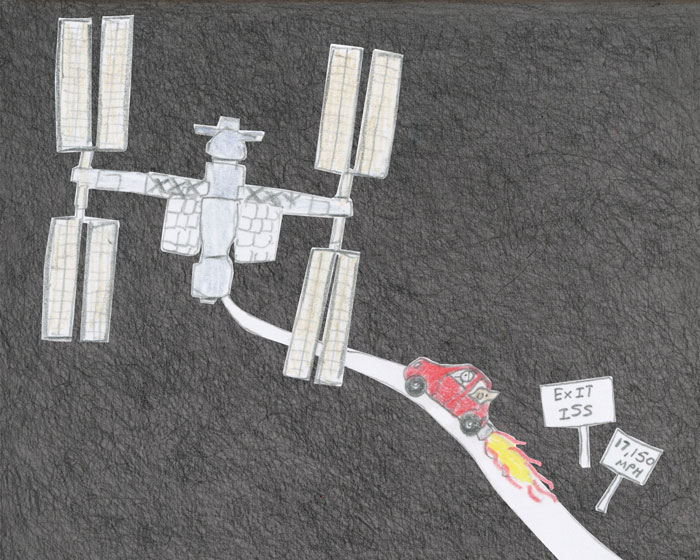Science Snippet:
How Far Can You See?


We can’t see objects on earth that are more than a few miles away. Because the earth is curved, our horizon is only about three miles away. But we can see farther than three miles if the object we are viewing is not at ground level or if we are on a tall building or mountain. In theory, you should be able to see the Hindutash Pass in China from the top of Mount Dankova which is 334 miles away in Kyrgyzstan. Unfortunately, this isn’t actually possible. Dust particles in the air affect visibility and the air molecules themselves scatter light making this impossible. Even if you are on a very tall mountain with a clear view you are limited to seeing about 150 miles. On rare occasions, a person might be able to see somewhat further. No one has even tried to take a photo across the China to Kyrgyzstan sightline. The longest distance someone has ever taken a photo on earth is 275 miles. In 2016, photographer Mark Bret Gumá took a picture of Pic Gaspard in the French Alps from Pic de Finestrelles in the Spanish Pyrenees.

What if we look towards the sky instead of across the earth? Earth has over 6,000 miles of atmosphere. With all those air molecules in the way, looking up seems useless. Fortunately, however, around 80% of all molecules in the atmosphere are in the bottom layer of the atmosphere (troposphere). The troposphere is only five to nine miles thick. Looking out from a high mountain across the earth’s surface creates problems because we are looking through the thick tropospheric air. But looking up, we only have a few miles of thick air before we get to the thin air of the upper atmosphere.

Is today clear? If it’s not, what’s causing this condition? A layer of clouds. When you see clouds, you aren’t actually seeing very far. If you are looking up at a dull grey cloud deck, it’s likely that the layer is at most a mile away. Many clouds are higher than this. Thunderheads can reach amazing heights, higher than any other cloud. But even the top of a towering thunderhead is still only around 14 miles away. That’s further away than the horizon. But on any clear day, I can go out of my house and look west toward the Rocky Mountains. There is a prominent peak called Doublehead Mountain which is almost exactly as far away as the top of the highest thunderhead.

From time to time, I have been looking at the night sky when a brilliant point of light moves overhead. This is the International Space Station. (If you want to find the International Space Station in your own sky, you can use NASA’s spot the station tool.) Now we’re gaining some distance. The International Space Station orbits the earth at a distance of 254 miles. This is farther than any distant object that is actually visible on earth, even though in theory we could see somewhat farther. (Actually, we couldn’t unless you want to accompany me to Kyrgyzstan. Unfortunately, there’s nothing to see when you get there.) If we could somehow drive at highway speeds toward the International Space Station, we could get there in around two and a half hours, assuming we set out from the Abu Dhabi-Al Ain highway in the United Arab Emirates (which has the highest speed limit in the world) and that the station was sitting still. Of course, when astronauts go to the space station, they don’t use cars; they use rockets. And a rocket flight to the station takes around six hours. Rockets go faster than cars, but the International Space Station is itself moving at a speed of 17,136 miles an hour, which makes getting there somewhat complicated. The rocket must take a strange spiral trajectory that ends up in front of the station. Then the astronauts allow the space station to catch them. This is much more tricky than it sounds. Ending up in the path of a one-million-pound object moving at 17,136 miles an hour hardly sounds like a good idea. Surprisingly, however, this is the best method of doing it.

The International Space Station is a satellite. All objects natural or artificial that orbit the earth or other planets are satellites. The International Space Station is very close compared to the distance of another one of Earth’s satellites—the Moon, which is our only natural satellite. At 238,900 miles away, it is almost 1000 times as distant from us as the space station. It takes about three days for one of our rockets to reach the moon. (Strange as it may appear at first, the Moon is only traveling at 2288 miles per hour, which is much slower than the International Space Station. The further an object is from the body it is orbiting the slower it moves.) Compared to other objects in our sky, the moon is quite close. In a series of upcoming posts, we will explore just how far we can see looking away from our earth out into our solar system and beyond. Along the way, we will stop to study the objects we are looking at in detail. For instance, you probably have seen the moon many times. But have you ever projected a moon image? Or tried to hunt for the thinnest possible crescent moon? Have you studied the differences between a summer moon and a winter moon? By the end of the series, we will be trying to find things that are much further away than the moon. Just how far away do you think you can see?
